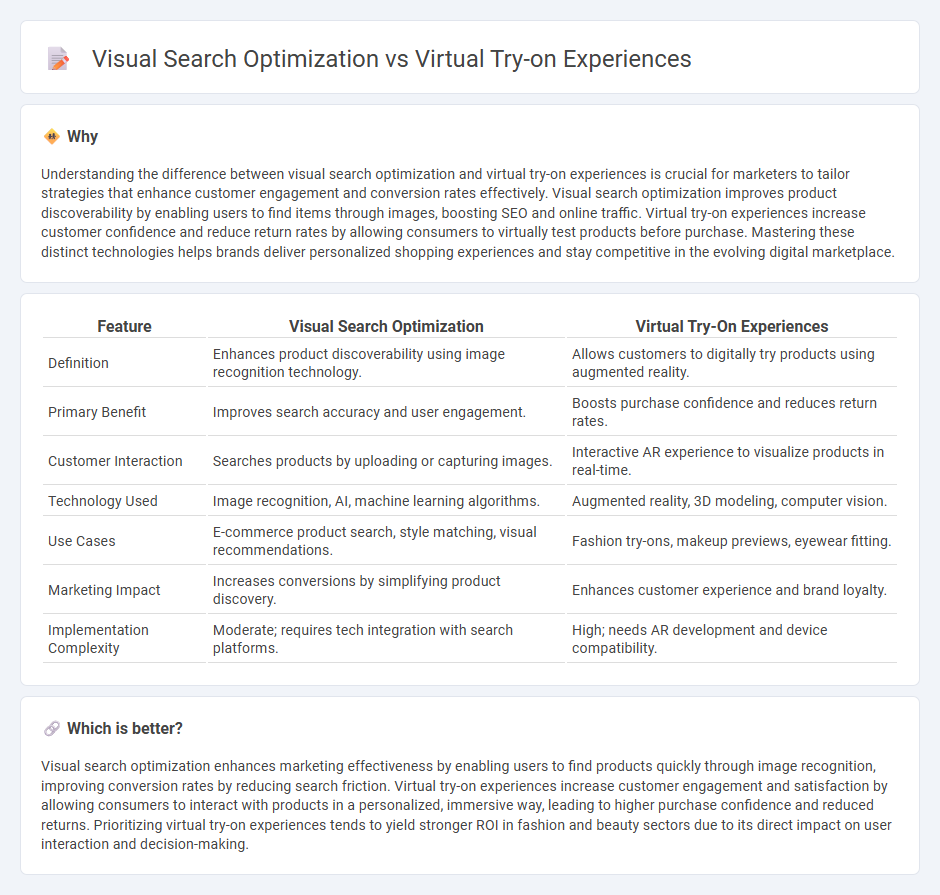
Visual search optimization enhances user engagement by enabling consumers to find products effortlessly through image-based queries, boosting conversion rates and reducing bounce rates on e-commerce platforms. Virtual try-on experiences leverage augmented reality technology to allow customers to visualize products like clothing or cosmetics in real time, significantly increasing purchase confidence and lowering return rates. Explore how integrating these cutting-edge marketing tools can transform your digital storefront and elevate customer satisfaction.
Why it is important
Understanding the difference between visual search optimization and virtual try-on experiences is crucial for marketers to tailor strategies that enhance customer engagement and conversion rates effectively. Visual search optimization improves product discoverability by enabling users to find items through images, boosting SEO and online traffic. Virtual try-on experiences increase customer confidence and reduce return rates by allowing consumers to virtually test products before purchase. Mastering these distinct technologies helps brands deliver personalized shopping experiences and stay competitive in the evolving digital marketplace.
Comparison Table
| Feature | Visual Search Optimization | Virtual Try-On Experiences |
|---|---|---|
| Definition | Enhances product discoverability using image recognition technology. | Allows customers to digitally try products using augmented reality. |
| Primary Benefit | Improves search accuracy and user engagement. | Boosts purchase confidence and reduces return rates. |
| Customer Interaction | Searches products by uploading or capturing images. | Interactive AR experience to visualize products in real-time. |
| Technology Used | Image recognition, AI, machine learning algorithms. | Augmented reality, 3D modeling, computer vision. |
| Use Cases | E-commerce product search, style matching, visual recommendations. | Fashion try-ons, makeup previews, eyewear fitting. |
| Marketing Impact | Increases conversions by simplifying product discovery. | Enhances customer experience and brand loyalty. |
| Implementation Complexity | Moderate; requires tech integration with search platforms. | High; needs AR development and device compatibility. |
Which is better?
Visual search optimization enhances marketing effectiveness by enabling users to find products quickly through image recognition, improving conversion rates by reducing search friction. Virtual try-on experiences increase customer engagement and satisfaction by allowing consumers to interact with products in a personalized, immersive way, leading to higher purchase confidence and reduced returns. Prioritizing virtual try-on experiences tends to yield stronger ROI in fashion and beauty sectors due to its direct impact on user interaction and decision-making.
Connection
Visual search optimization enhances user engagement by enabling customers to find products quickly through images, while virtual try-on experiences increase conversion rates by allowing users to virtually test products before purchasing. Both techniques rely on advanced AI and machine learning algorithms to deliver personalized and immersive shopping experiences. Integrating these technologies helps marketers drive higher brand interaction and improve e-commerce performance through seamless, visually-driven customer journeys.
Key Terms
Augmented Reality (AR)
Virtual try-on experiences leverage Augmented Reality (AR) technology to enhance e-commerce by allowing consumers to visualize products like clothing, accessories, or cosmetics in real-time on their own image, increasing engagement and purchase confidence. Visual search optimization uses AR to enable users to identify and shop for products directly from images or live camera feeds, streamlining product discovery and boosting conversion rates. Explore how AR-driven virtual try-ons and visual search optimization are transforming retail to stay competitive in today's digital market.
Computer Vision
Virtual try-on experiences leverage computer vision algorithms to accurately map garments onto a user's body, enhancing personalization and purchase confidence by simulating real-world fitting. Visual search optimization employs image recognition and feature extraction to enable users to find products through photos, improving search accuracy and user engagement in e-commerce platforms. Explore how advanced computer vision technologies are revolutionizing retail shopping through these innovative applications.
Conversion Rate
Virtual try-on experiences significantly boost conversion rates by offering immersive, personalized interactions that reduce purchase hesitation and product returns. Visual search optimization enhances conversion by enabling users to find exact or similar products quickly through image-based queries, streamlining the shopping journey. Explore how integrating these technologies can maximize your e-commerce conversion potential.
Source and External Links
9 Examples on How Retail Can Use Virtual Try-On Technology - Virtual try-on technology uses AR and AI to let customers virtually experience products, enhancing personalization, speeding decision-making, reducing returns, and improving customer experience across brands like Zara, Nike, and Warby Parker.
Virtual Try-On for E-commerce: A Complete Guide - Zakeke - Virtual try-on allows customers to see how products such as glasses, clothing, and shoes will look and fit on them before purchasing, offering a comfortable, hassle-free shopping experience at home.
Virtual Try-On Technology for the Luxury Industry: How It Works ... - Luxury brands like Chanel and Louis Vuitton use AR-powered virtual try-on technology to provide immersive, realistic product simulations with high customization, improving online customer satisfaction and engagement.
 dowidth.com
dowidth.com